After two years of virtual conferences, the Sitecore community descended on McCormick Place in Chicago for Sitecore Symposium 2022, their flagship user conference, to see how the transformation of their product from monolithic DXP to a composable suite of products was going. The event had several surprise announcements, and there were plenty of insights into where Sitecore is going that can better help you plan your own roadmap.
Here are my Top Ten Takeaways from the Sitecore Symposium 2022:
1. XM Cloud is the Successor to XP, not XM
XM Cloud was released over the summer, and the general thinking coming into Symposium was that it was Sitecore’s XM product delivered in a SaaS package, with Personalization and Analytics requiring Sitecore CDP and Personalize to attempt.
Sitecore Chief Product Officer Dave O’Flanagan corrected this view, saying that “XM Cloud was the successor to XP, not to XM” during the Product Keynote.
He went on to show how Personalization will be baked into XM Cloud, allowing a rules engine-like experience for targeting page variants to different audiences. In breakout sessions that went into more detail, we learned that this was powered by a light version of Sitecore’s CDP and Personalize products. The personalization was executed at the edge using Next.JS Middleware.
This light version of CDP will also surface basic web analytics and page performance metrics within the XM Cloud portal.
These features are not an add-on but will be part of Sitecore’s base XM Cloud offering.
2. Sitecore is Reorganizing its offerings into Content Cloud, Engagement Cloud, and Commerce Cloud
CEO Steve Tzikakis announced three new products in the first Keynote: Content Hub One, Sitecore Search, and Sitecore Connect. With these new products and a reorganization of Content Hub’s offerings, Sitecore’s SaaS products can be broken into three groups: “Content Cloud,” “Engagement Cloud,” and “Commerce Cloud.”

Content Cloud is made up of XM Cloud, Content Hub One, Content Hub DAM, Content Hub Operations, and Sitecore Search. Content Hub Operations is a rebranding and enhancement of MRM to help with planning and executing marketing projects and campaigns.
Engagement Cloud is made up of Sitecore CDP, Sitecore Personalize, Sitecore Send, and Sitecore Connect.
Commerce Cloud is made up of Order Cloud and Sitecore Discover.
3. New Offering: Content Hub One, A Basic Headless CMS
Content Hub CMP has been enhanced with updated UI features to make managing simple content structures easier. Together with the ability to publish to Experience Edge, Content Hub will provide an alternative headless CMS for simpler scenarios that are focused on a simpler content entry experience.
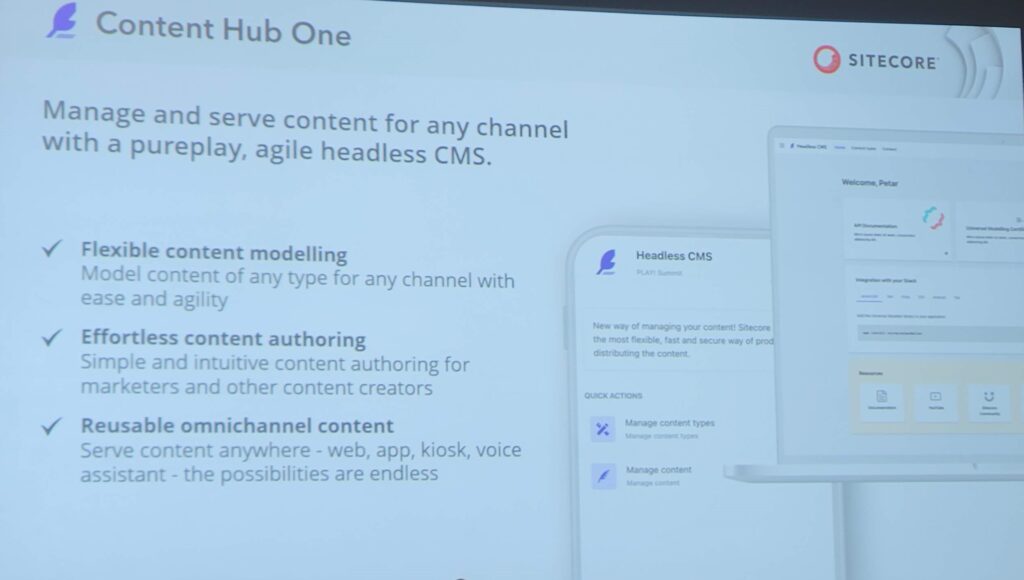
With this approach, content authors use the Content Hub interface to enter content into form fields. The UX has been expanded to make it easier to create lists and other relationships between content, but in the end, it only models the content, not how it will display on the screen.
Developers would create their own applications to fetch that content and display it. Since published content is cached at the edge using Experience edge, performance should be very good. This provides an alternative (probably at a lower price point) to XM Cloud that is more in line with competitive headless solutions in the market.
4. New Offering: Sitecore Search, Content Search Powered by Reflektion technology
After acquiring Reflektion with the search technology behind Sitecore Discover, Sitecore has created a more general content search tool for creating search experiences. This product can be used to deliver faceted site search experiences that provide tools for marketers to raise results in ranking while giving insights into the effectiveness of results through analytics.

It already powers search on Sitecore’s website.
5. New Offering: Sitecore Connect, a Low Code Integration Platform
With all these products, integration becomes a critical need. To solve this, Sitecore announced Sitecore Connect, a Low Code Integration platform that extends “Workato,” a leader in this space.
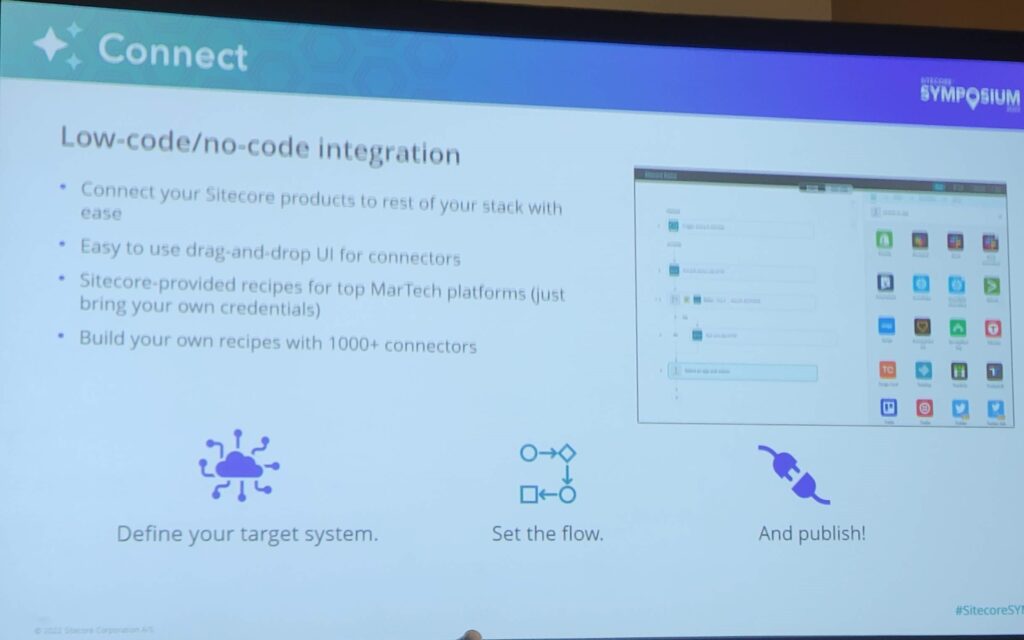
Sitecore is already working on building connectors and recipes for this platform to connect XM Cloud, CDP, Personalize, Send and More when it launches.
6. New Tool: Cloud Portal, Access Everything in One Place
With a portfolio of products, providing access to them in a single interface makes them easier to use together. Available now, the Cloud portal provides a front door not only into Sitecore’s tools but other tools as well. Their demo screenshots showed access to Microsoft Teams, Salesforce, and Marketo.

7. XM Cloud Will Have Unique Capabilities
Besides integrated personalization and analytics, there were several other new aspects of XM Cloud were revealed. XM Cloud components were introduced as a front end as a service way to inject Web components into a website. And these components can bind to any data source, whether XM cloud, Content Hub One, or any other headless CMS. While I’m not sure, I suspect these will behave similarly to web templates in Sitecore Personalize.
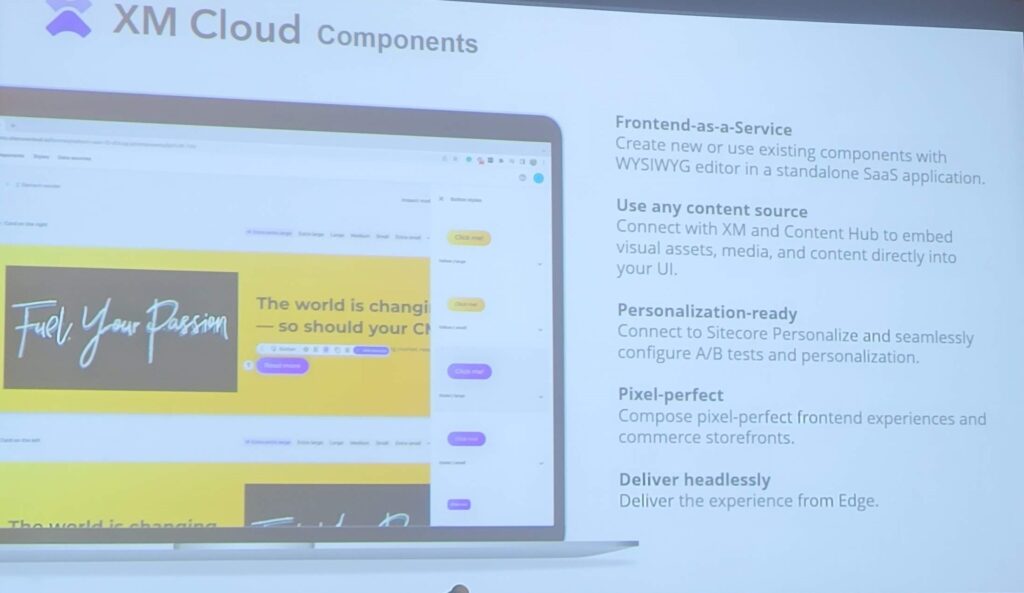
We also got a peek at the XM Cloud Forms builder, which will allow marketers to create custom forms that can be embedded in sites.
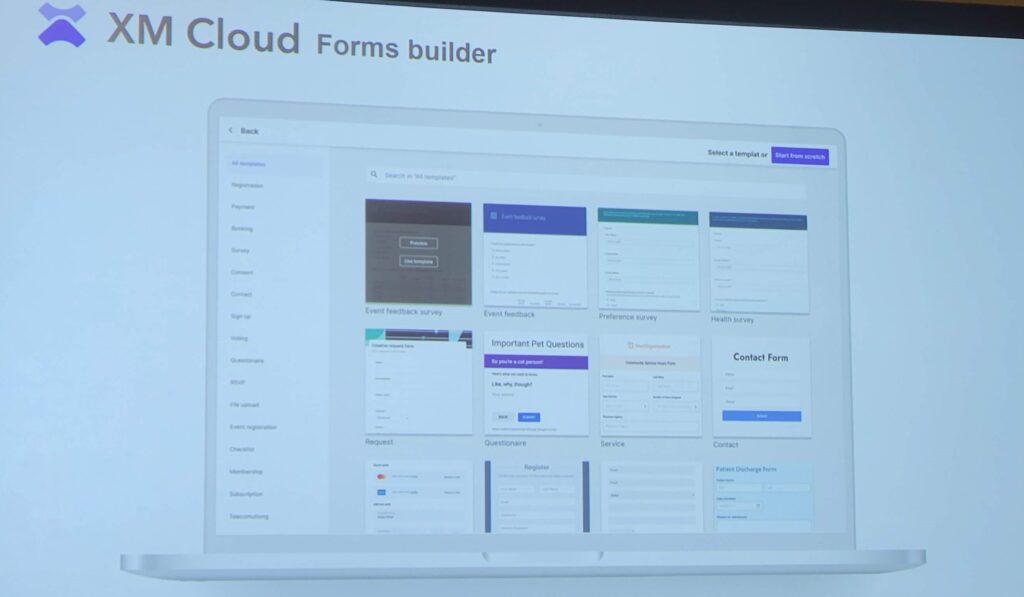
8. Sitecore 10.3 will make it easier to transition
For most customers who are not on SaaS yet, Sitecore did announce that 10.3 will be available soon. This release focused on extensibility and interoperability to make integrating with Sitecore SaaS solutions using webhooks easier. A lot of focus was on what is the migration path to XM Cloud when it makes sense to stay on it, when it makes sense to supplement it with other SaaS Products, and when it makes sense to replace it.
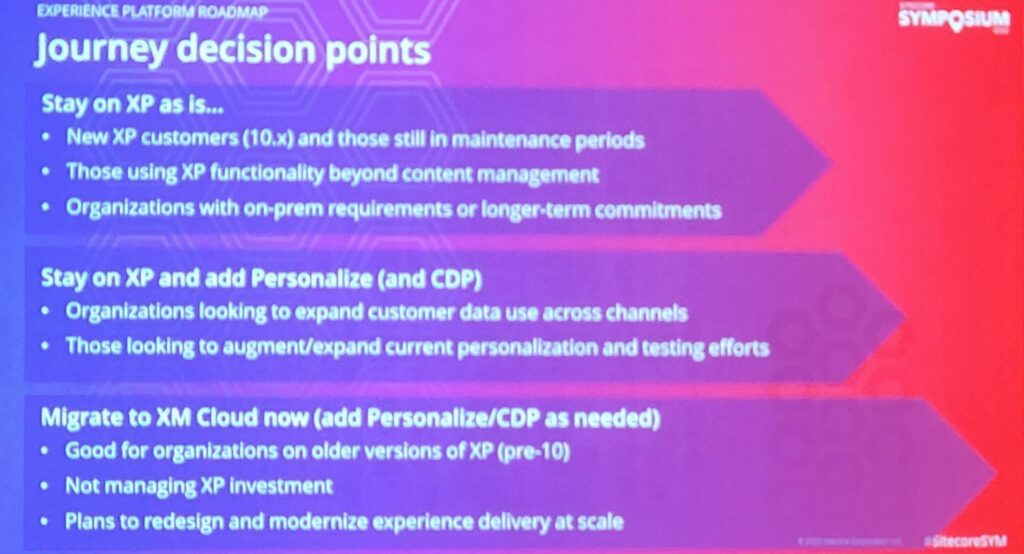
That being said, one feature being introduced in 10.3 is codeless xDB schema changes. I’m excited about this feature because extending xDB in the past was pretty painful, requiring both code changes and deployments. Still, configuration changes in several xDB-related services to get everything working. I do worry that making it easier to use may cause more issues as you’ll need to account for migrating that data if you do end up going to XM Cloud and Sitecore CDP.
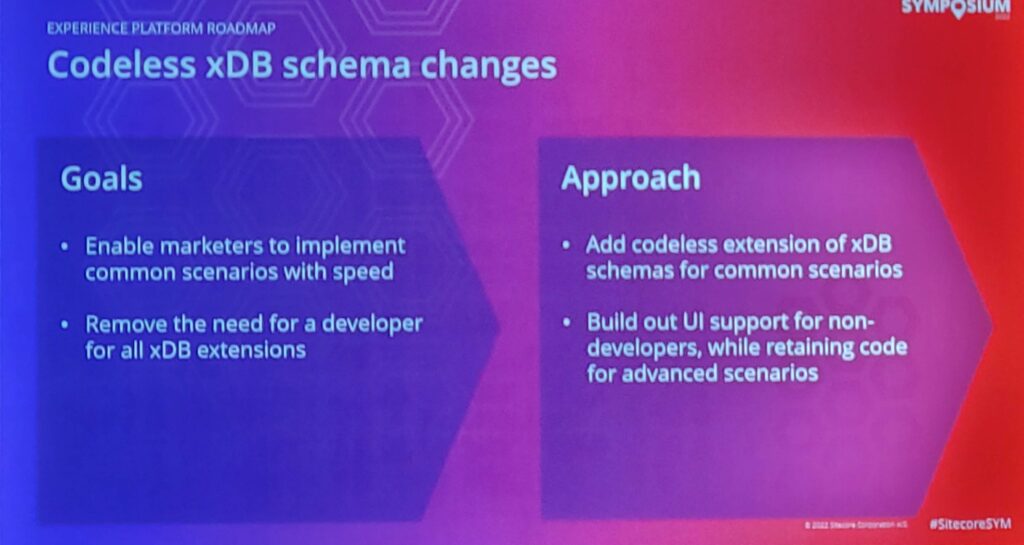
9. SXA is Going Headless
Headless SXA is bringing the useful parts of Sitecore’s Experience Accelerator to headless architectures including automation, page designs, partials, XML Sitemaps, and more. You can even do rendering variants, though your component implementation needs to handle the markup for each variant. Do keep in mind headless SXA is currently being built for Next.JS and not the other headless frameworks Sitecore supports.
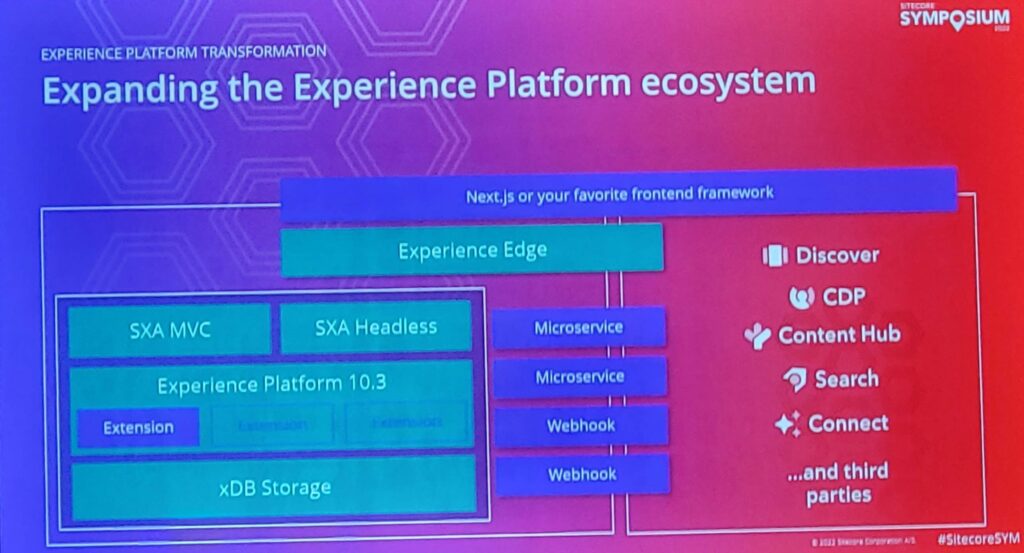
SXA also has better support for Sitecore Pages, XM Cloud’s new page editing experience. It will support SXA’s grid, styles, and other authoring features to make it easier to use with SXA sites.

In some of the keynotes and sessions on XM cloud, the idea of a site factory and being able to make it easy for marketers to provision and deploy sites was noted. I’m assuming much of this is going to be built on top of SXA’s automation features and Sitecore Powershell.
Another interesting feature announced for both regular and headless SXA was support for Site Specific Standard Values. This will allow sites to provide different default values for templates, avoiding the need to create duplicate templates to drive different default behavior.
10. Everything is Getting More Integrated
We are just starting to see how all these products will work together to make a better experience. Audiences in Sitecore CDP will be able to be used to target people in XM Cloud. Sitecore Connect will move data to and from your CRM. And they announced a future unified tracking feature that will allow a single set of events and data to push data where it needs to go across all the products.
![]()
With everything moving to SaaS, the connections between products in a unified interface will become even more prevalent. And not needing to upgrade to get these features makes it even more compelling.
Wrapping Up
Sitecore Symposium 2022 clearly showed how Sitecore is investing in Composable, SaaS and Headless, and how their products will fit together to create an even more compelling offer than looking at them individually.
Want to know how you should take these takeaways into account when planning your roadmap? We’d love to talk. Reach out to me on LinkedIn, or Twitter or fill out our contact form.

